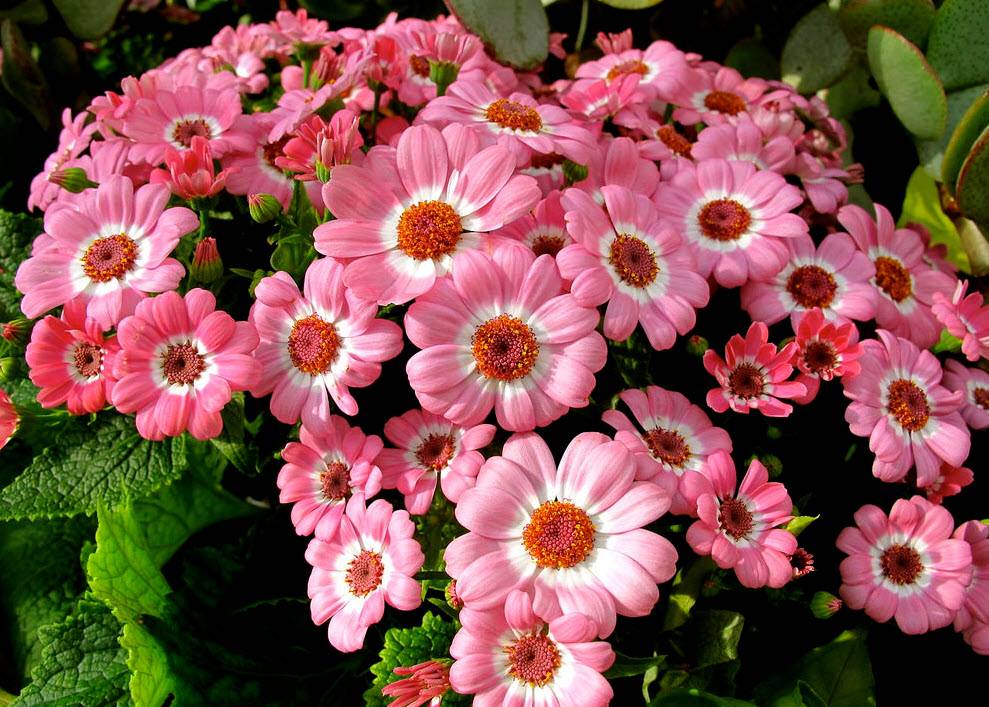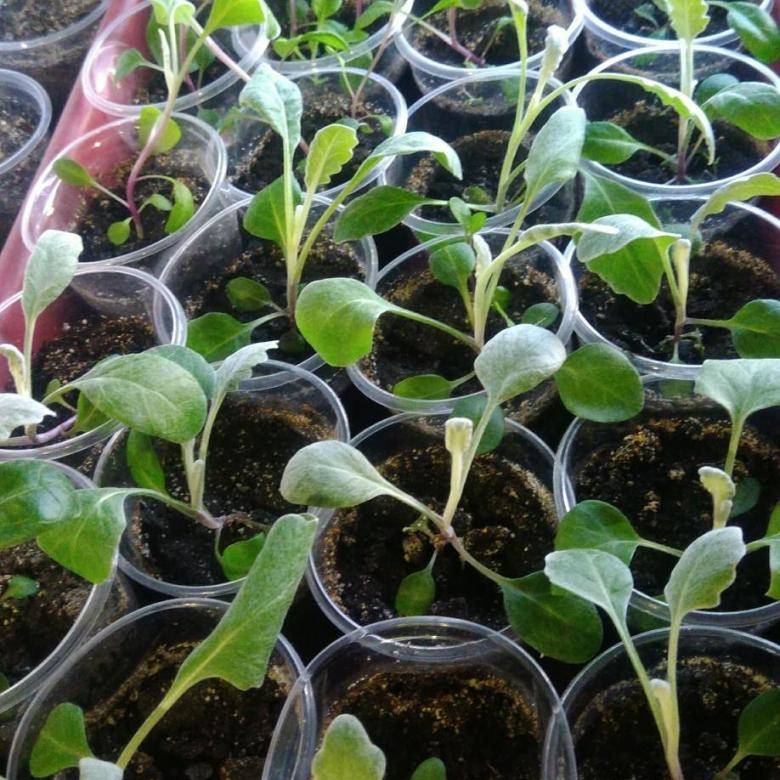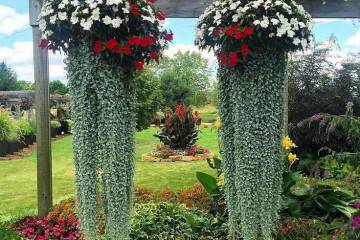Cineraria silvery - growing from seeds at home
Content:
The cineraria flower is in great demand among gardeners. He has an unpretentious character and an unusual appearance that allows him to transform the suburban area. Indoor cineraria exist comfortably at home, hybrids allow you to create unusual flower arrangements.
What does cineraria silvery look like?
A shrub with spectacular foliage will take root perfectly in any garden area. Caring for it cannot be called burdensome, despite the southern origin of the plant.
What family does it belong to
Cineraria belongs to the Astrov family. The plant resembles representatives of the flora belonging to the genus Rustic. These are annual and perennial grasses, shrubs, common throughout the world. Ragwort species live both in the tropics and in the northern regions.
History of appearance
Cineraria is native to the Mediterranean countries. Nevertheless, she does not really like the heat, she prefers coolness.
The name is translated from Latin as "ashy". This is the best description for an unusual plant. The leaves of the cineraria are really silvery, which favorably distinguishes it from other neighbors in the flower bed.
Plant characteristic
There are about 50 types of cineraria, and many more varieties have been developed. Plants are unpretentious in nature, for which they are in demand among gardeners;
- some are valued as decorative leafy representatives of the flora, the flowering of which cannot be called colorful, for example, seaside cineraria;
- others are eye-catching with vibrant daisy-like flowers. Their shades, shape are significantly different, which allows you to create a unique composition in the garden.
Cineraria has a silvery juicy green leaf covered with a grayish pile. From a distance, the feeling is created that the plant is covered with frost. The buds do not add attractiveness, so they are usually disposed of as soon as they appear.
Popular varieties
The leaf plates of the cineraria are markedly different. Depending on the variety, their color changes. When choosing a flower, you should pay attention to the height of the shrub. Among the silvery cineraria, there are undersized representatives, and tall plants are also found.
Silver dust
Cineraria Silver dust is a small shrub, the height of which is usually less than 25 cm. The leaves are pinnate with serrated silver-white, as if covered with snow.
Cirrus
The plant has rather large leaves, they are oval, but also have serrations, but unlike other flowers, they are not dissected. At first they are silvery green, eventually becoming almost white.The shrub usually does not exceed 30-35 cm.
Andromeda
Andromeda is the smallest representative of marine cineraria. The leaves are pinnate and strongly divided. The bush does not grow more than 15 cm.
Candyance
The herbaceous plant reaches 25 cm in length. The leaves are gray-silvery, palmate, they grow densely.
Diamond powder
Leaves are dense, elongated and directed upward. They are carved openwork silver-ash color. The height of the shrub does not exceed 20 cm.
Types of cineraria
If you want to create a bright flower bed, then, in addition to silvery cineraria, it is better to use other types of plants.
Bloody
Bloody cineraria is a hybrid plant that will create a real colorful carpet at the summer cottage. Flowers can be not only red, but also purple, white, blue. They grow so densely that the greenery is lost sight of.
Graceful
In graceful cineraria, the stem is strongly branched. The plant is characterized by lush flowering. It grows rapidly in width, which must be taken into account when planting. Flowers can be scarlet, purple.
How the plant reproduces
Usually, seedlings are used to obtain an attractive shrub. You can purchase seeds at a flower shop. Cutting and dividing the bush are used, but much less often.
Growing from seeds
It is not difficult to propagate cineraria, the main thing is to follow all the recommendations in order to transplant young bushes to the summer cottage without any problems by May.
Time to board
Sowing is best planned for early April. Then, by the end of the frost, the plants will already be ready for transplanting into open ground. If the nights remain cold, then you need to take care of the covering material.
Choice of capacity
Planting material is sown in special boxes for seedlings. After the shoots appear, you need to move the future shrubs to a lighted place. This usually happens after 7-10 days. When a pair of leaves is formed on the shoots, it is time for a pick.
Soil and seed preparation
No special preparation is needed before growing cineraria from seeds. In advance, the planting material can be soaked in a growth-stimulating solution. Almost all seeds germinate, the germination rate is very high. They need to be placed in loose soil with the addition of sand and peat. It is not necessary to bury it in the ground, it is enough to distribute it over the surface and crush the top layer of the earth. After that, you need to moisten the soil:
- use a spray bottle;
- pour water into the tray containing the seedling box.
Seedling care
In order for the seeds to germinate, it is necessary to create a greenhouse environment - cover the box with glass or stretch the film. You cannot water them, just spray them periodically after the earth dries out.
Dive and transfer
When the cineraria get stronger, acquire leaves, they need to be transplanted into separate containers.
You can use special pots made of peat, so that when transplanting to a permanent place, you do not injure the plants. It is necessary to transplant with a lump of earth, but if you remove the flower from the container, as there is a risk of damaging the underground part.
Planting cuttings
Deciduous cineraria propagate by cuttings:
- You need to prepare shoots about 10 cm long.
- Fill the container with soil consisting of garden soil and sand.
- Treat the cutting with a solution that promotes root growth and stick it into the ground.
- Put on a plastic bottle to create the necessary moisture.
- Check the condition of the soil every two days, water if necessary.
Dividing the bush
Reproduction of cineraria in this way must be carried out before it blooms. The plant is carefully dug up along with the ground, washed and the roots are divided into parts. You will get 2 or 3 new shrubs, each with roots and shoots.
Features of care in the garden
Caring for cineraria does not require much time and effort. The main thing is to decide on a place for the plant, not to close it from the wind and regulate watering.
Comfortable conditions
Cineraria loves sunlight, but it is worth protecting it from the scorching rays. The plant feels good in the fresh air, is not afraid of drafts. It can survive drought and low temperatures around 10-15 ° C.
What is the plant afraid of
Excessive soil moisture leads to root rot. If the soil is too dry, the plant will begin to wither and lose its attractive appearance. It prefers coolness, it is harder to endure heat.
Watering
Moisten the soil after the top layer dries. It is necessary to water at the root, make sure that the liquid does not get on the leaves of the plant.
Mulching
It is only necessary to resort to mulching when the plants are still young and have not had time to get stronger. This is usually required if, after transplanting into open ground, there is a risk of frost at night.
Loosening
The condition of the soil must be monitored. It will have to be loosened as needed, it is better to do this after each watering.
Top dressing
Deciduous cineraria require mineral fertilizers. Flowering shrubs also need organic matter. They need to be alternated with fertilizing with minerals.
Transfer
The shrub is transplanted after 2-3 years. The need for the procedure is associated with the appearance of the flower. It loses its decorative effect, weakens, stops growing.
When and how it blooms
Ornamental deciduous plants bloom inconspicuously. They are bred mainly as a background, the basis of a flower bed. Dense plantings of cineraria turn into a silvery carpet that transforms any lawn. Flowering plants differ from each other in shape, color of buds.
Types of flowers
Shades of flowers of hybrids can be different. In addition to monochrome purple, blue, red, lilac, there are two-color cineraria.
Flower shapes
Usually, cineraria flowers resemble daisies. Their petals differ in length, width, the ends can be sharp, spatulate or rounded. In some cineraria of hybrid varieties, they twist.
Flowering period
Flowering begins in June and continues until frost. Cineraria silvery during this period does not change. Small yellow flowers are usually cut off to conserve the plant's vigor.
Leaving during flowering
Under indoor conditions, cineraria blooms 9 months after sowing the seeds. Before winter, the plant is dug up and transported home, it turns into a potted flower.
It is better to remove wilted buds from a flowering plant, so the colorful period will last longer. After it, the bush is dug up, because it is usually grown as an annual. If you want to keep the flower, it is transferred to a cool room for the winter, transplanting it into a pot.
Growing problems
Despite the fact that cineraria is unpretentious to care for, gardeners may face a number of problems associated with the actions of pests, infection with various diseases.
Pests
Usually the life of cineraria is poisoned by spider mites, whiteflies and aphids. To get rid of them, you need to treat the plant with soapy water. If there is no effect, you need to turn to insecticides.
Diseases
Most often, cineraria is affected by:
- gray rot, when off-white fluffy spots appear on the leaf plates;
- rust is a fungal disease that spreads on leaves and shoots. Yellow dots turn into red spots. If you do not take treatment, the plant may die;
- powdery mildew. The disease is also associated with the action of fungi. Light spots become noticeable on the leaves, over time they turn into a gray bloom. The shrub withers away, stops growing.
Signs of improper care
Ignoring care recommendations affects the appearance of the plant:
- there is no flowering;
- leaves turn yellow, wither, spots and bloom appear on them. As a result, they begin to fall off;
- the flower stops growing and developing.
Use in landscape design
Ornamental deciduous shrubs are used to decorate flower beds, shading flowering plants. With their help, borders are drawn up in summer cottages, they divide the territory, look good thanks to the silvery foliage. Blooming cineraria are perfectly combined with other plants, which allows you to arrange colorful flower beds in summer cottages, squares, parks.
It is not difficult to take care of the cineraria bush. An annual plant can be turned into a perennial by sending it indoors for the winter. It easily gets along on any part of the summer cottage, is used in landscape design, transforming the backyard territory.




















